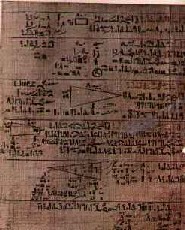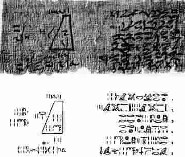|
The
ancient Egyptian civilisation developed on the banks of the Nile about
four thousand years before Christ. We have been able to learn about
their system for recording words and
numbers by using hieroglyphic symbols from papyrus
manuscripts. Although the Babylonian tablets survived for so long so
well, this wasn't the case with the papyrus documents. However, understanding the system has been
made much easier since the discovery of the Rosetta
Stone in 1799. This large tablet is inscribed with
text written in three different scripts: Greek, Demotic (the local
language) and hieroglyphs. This allowed hieroglyphs to be translated
into Greek and then into other languages. The most important
mathematic document to have been discovered is the Rhind
Papyrus (named after the Scottish antiquary who
found it in 1858) or the Ahmes Papyrus
(as it is also known, named after the scribe who copied it in about
1650 B.C. The material appears to have belonged to the Middle Kingdom
(2000 to 1800 B.C.) and some of its knowledge may have come from
Imhotep, who was the architect in charge of the building of Pharaoh
Zoser's pyramid about 5,000 years ago. Other papyri of great
importance are the Kahun Papyrus, the Berlin Papyrus and the Moscow
Papyrus. The Rhind Papyrus and the Moscow Papyrus both contain examples
of mathematical problems. The table below reflects the
extent of mathematical knowledge during ancient Egyptian civilisation.
It is important to bear in mind that the Egyptians used mathematics to
solve everyday problems (e.g. to survey the land by the Nile which was
often flooded when the river burst its banks and to construct
pyramids). All the examples
refer to specific cases, concrete shapes with fixed measurements,
which are descriptive but do not include what we nowadays refer to as proof.
These particular examples were probably used as teaching material at
the time.
| Hieroglyphic
script
|
 |
Left:
The Rhind Papyrus inscribed with hieratic script 1650 B.C.
Right: The Moscow Papyrus |
 |
| Number
theory |
- Whole
fractions and 2/3
- Addition,
multiplication and division using the duplication process and the
"rule of three".
|
| Algebra |
- Algebraic
problems which are solved using the "method of false
position".
The unknown is referred to as a heap:
- Problem 24: Work out
the value of the heap if the heap and a seventh of the heap is equal
to 19.
- Solution:
Choose a possible value for the heap, e.g. 7, carry out the operations
and you get 8 as an answer. Compare 8 to 19 and you see that you have
to multiply 8 by (2+1/4+1/8) to get 19. In the same way multiply the
brackets by 7 to get the value of the unknown heap. Finally
show that 7·(2+1/4+1/8)=16+1/2+1/8, which is the value of the unknown
heap. As you can see, only unit fractions are used.
|
| Geometry |
|
|




